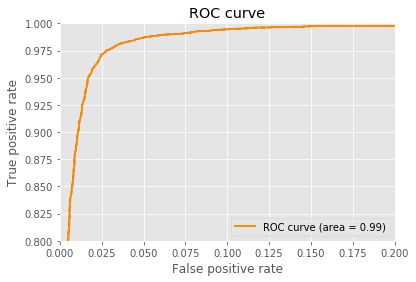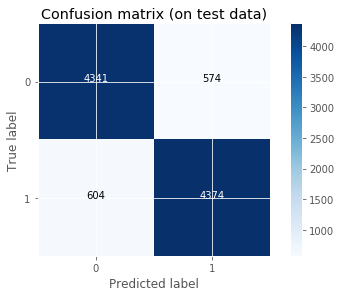H2o Automl
Analyze the Bottle Rocket dataset using H2O AutoML
This is our second generation model. The models for the first generation analysis were summarized on October 17, 2017. A lot has happened since then. This analysis was done on August 2, 2018. We have achieved a major improvement in the results. Please see the Summary below.
import platform, time, sys
import numpy as np
import pandas as pd
import matplotlib
from matplotlib import pyplot as plt
%matplotlib inline
import itertools
from imblearn.over_sampling import SMOTE
from tabulate import tabulate
import seaborn as sns
from sklearn.metrics import accuracy_score, auc, classification_report, confusion_matrix, f1_score
from sklearn.metrics import log_loss, mean_squared_error, precision_score, recall_score, r2_score
from sklearn.metrics import roc_auc_score, roc_curve
from sklearn.model_selection import train_test_split
import h2o
from h2o.automl import H2OAutoML
import warnings
warnings.filterwarnings("ignore")
print('Operating system version....', platform.platform())
print("Python version is........... %s.%s.%s" % sys.version_info[:3])
print('pandas version is...........', pd.__version__)
print('numpy version is............', np.__version__)
print('matplotlib version is.......', matplotlib.__version__)
Operating system version.... Windows-10-10.0.17134-SP0
Python version is........... 3.6.5
pandas version is........... 0.23.0
numpy version is............ 1.14.3
matplotlib version is....... 2.2.2
Start the h2o server
start_time = int(time.time())
localH2O = h2o.init(ip = "localhost",
port = 54321,
max_mem_size="24G",
nthreads = 6)
h2o.no_progress()
h2o.remove_all()
Checking whether there is an H2O instance running at http://localhost:54321..... not found.
Attempting to start a local H2O server...
Java HotSpot(TM) 64-Bit Server VM (build 25.181-b13, mixed mode)
Starting server from C:\Users\Charles\Anaconda3\lib\site-packages\h2o\backend\bin\h2o.jar
Ice root: C:\Users\Charles\AppData\Local\Temp\tmpawu4yul2
JVM stdout: C:\Users\Charles\AppData\Local\Temp\tmpawu4yul2\h2o_Charles_started_from_python.out
JVM stderr: C:\Users\Charles\AppData\Local\Temp\tmpawu4yul2\h2o_Charles_started_from_python.err
Server is running at http://127.0.0.1:54321
Connecting to H2O server at http://127.0.0.1:54321... successful.
H2O cluster timezone:
H2O cluster version: 3.21.0.4374
H2O cluster version age: 3 days
H2O cluster name: H2O_from_python_Charles
H2O cluster total nodes: 1
H2O cluster free memory: 21.33 Gb
H2O cluster total cores: 0
H2O cluster allowed cores: 0
H2O cluster status: accepting new members, healthy
H2O connection url: http://127.0.0.1:54321
H2O connection proxy: None
H2O internal security: False
H2O API Extensions: Algos, AutoML, Core V3, Core V4
Python version: 3.6.5 final
Define a correlation plot
def Correlation_plot(df_new, response_column):
plt.ioff()
red_green = ["#ff0000", "#00ff00"]
sns.set_palette(red_green)
np.seterr(divide='ignore', invalid='ignore')
g = sns.pairplot(df_new,
diag_kind='kde',
hue=response_column,
markers=["o", "D"],
size=1.5,
aspect=1,
plot_kws={"s": 10})
g.fig.subplots_adjust(right=0.9)
plt.show()
Define a method to get the data set, and split it into train, validate, test
def Get_Model_Data():
path = 'https://raw.githubusercontent.com/CBrauer/CypressPoint.github.io/master/model-13-1.csv'
model = pd.read_csv(path)
feature_columns = ['BoxRatio','Thrust', 'Velocity', 'OnBalRun', 'vwapGain']
response_column = ['Altitude']
mask = feature_columns + response_column
# Correlation_plot(model[mask], response_column)
X = model[feature_columns].values
y = model[response_column].values.ravel()
sm = SMOTE(random_state=12)
X_resampled, y_resampled = sm.fit_sample(X, y)
X_train, X_test, y_train, y_test = train_test_split(X_resampled,
y_resampled,
test_size = 0.3,
random_state = 0)
# reshape so we can append the columns
y_train_ = y_train.reshape(y_train.shape[0], 1)
df_train = pd.DataFrame(X_train, columns=feature_columns)
df_train[response_column] = pd.DataFrame(y_train_).astype(int)
print('train: \n', df_train.head(5))
y_test_ = y_test.reshape(y_test.shape[0], 1)
df_test = pd.DataFrame(X_test, columns=feature_columns)
df_test[response_column] = pd.DataFrame(y_test_).astype(int)
print('test: \n', df_test.head(5))
train = h2o.H2OFrame(df_train)
train[response_column] = train[response_column].asfactor()
X_train = train[feature_columns]
y_train = train[response_column]
test = h2o.H2OFrame(df_test)
test[response_column] = test[response_column].asfactor()
X_test = test[feature_columns]
y_test = test[response_column]
return X_train, y_train, X_test, y_test, train, test, feature_columns, response_column
Plot the ROC curve
def ROC_Curve(best_model, train):
performance = best_model.model_performance(train)
auc = performance.auc()
false_positive_rate = performance.fprs
true_positive_rate = performance.tprs
plt.style.use('ggplot')
plt.figure()
plt.plot(false_positive_rate, true_positive_rate, 'k--')
plt.plot(false_positive_rate,
true_positive_rate,
color='darkorange',
lw = 2,
label='ROC curve (area = %0.2f)' % auc)
plt.plot([0,1], [0,1], color = 'navy', lw = 2, linestyle = '--')
plt.xlim(0, 0.2)
plt.ylim(0.8, 1)
plt.xlabel('False positive rate')
plt.ylabel('True positive rate')
plt.title('ROC curve')
plt.legend(loc='best')
plt.show()
Plot the performance of each predictor
def Plot_predictor_importance(best_model):
fig, ax = plt.subplots()
variables = best_model._model_json['output']['variable_importances']['variable']
y_pos = np.arange(len(variables))
scaled_importance = best_model._model_json['output']['variable_importances']['scaled_importance']
ax.barh(y_pos,
scaled_importance,
align='center',
color='green',
ecolor='black',
height=0.5)
ax.set_yticks(y_pos)
ax.set_yticklabels(variables)
ax.invert_yaxis()
ax.set_xlabel('Scaled Importance')
ax.set_title('Variable Importance')
plt.show()
Plot the confusion matrix
def Plot_Confusion_Matrix(best_model):
y_predicted = best_model.predict(X_test)
y_predicted_ = y_predicted.as_data_frame(use_pandas=True, header=False)
y_pred = y_predicted_['predict']
y_test_ = y_test.as_data_frame(use_pandas=True, header=False)
y = y_test_[response_column]
cm = confusion_matrix(y, y_pred)
cmap = plt.cm.Blues
plt.imshow(cm, interpolation='nearest', cmap=cmap)
title='Confusion matrix (on test data)'
classes = [0, 1]
plt.title(title)
plt.colorbar()
tick_marks = np.arange(len(classes))
plt.xticks(tick_marks, classes, rotation=0)
plt.yticks(tick_marks, classes)
thresh = cm.max() / 2.
for i, j in itertools.product(range(cm.shape[0]), range(cm.shape[1])):
plt.text(j, i, cm[i, j],
horizontalalignment="center",
color="white" if cm[i, j] > thresh else "black")
plt.tight_layout()
plt.ylabel('True label')
plt.xlabel('Predicted label')
c_report = classification_report(y, y_pred)
print('\nClassification report:\n', c_report)
Print the model metrics for the validate and test data sets
def Print_Metrics(best_model, X_test, y_test):
print('\nModel performance on test data set:')
predictions = best_model.predict(X_test)
misclassification_rate = (predictions['predict'] == y_test).as_data_frame(use_pandas=True).mean()
performance = best_model.model_performance(test)
accuracy = performance.accuracy()[0][1]
precision = performance.precision()[0][1]
recall = 0.0 #performance.recall()[0][1] not available yet
F1 = performance.F1()[0][1]
r2 = performance.r2()
auc = performance.auc()
mse = performance.mse()
logloss = performance.logloss()
header = ["Metric", "Test dataset"]
table = [["accuracy", accuracy],
["precision", precision],
["recall", recall],
["misclassification rate", misclassification_rate],
["F1", F1],
["r2", r2],
["AUC", auc],
["mse", mse],
["logloss", logloss]
]
print(tabulate(table, header, tablefmt="fancy_grid", floatfmt=".8f"))
Load the Bottle Rocket dataset
X_train, y_train, X_test, y_test, train, test, feature_columns, response_column = Get_Model_Data()
train:
BoxRatio Thrust Velocity OnBalRun vwapGain Altitude
0 0.324000 0.615000 1.525000 3.618000 0.416000 0
1 0.938249 0.366377 2.402230 6.393223 2.667106 1
2 0.317000 -0.281000 0.979000 1.489000 0.506000 0
3 0.289000 -0.433000 0.796000 2.081000 0.536000 0
4 1.551115 -0.103734 0.731682 1.752156 0.667016 1
test:
BoxRatio Thrust Velocity OnBalRun vwapGain Altitude
0 0.051000 -0.419000 0.351000 1.173000 0.571000 0
1 3.832137 0.933219 0.918407 3.290789 0.501965 1
2 1.252387 2.489781 1.461396 4.268061 1.055923 1
3 0.000000 -0.814201 0.883223 1.960900 0.269550 1
4 0.222000 -0.296000 1.057000 2.714000 0.808000 0
Define the AutoML model.
def Run():
aml = H2OAutoML(max_models = 500,
seed = 7,
max_runtime_secs = 1*60*60,
nfolds = 5,
stopping_metric = "misclassification",
project_name="bottle_rocket",
stopping_rounds = 5)
aml.train(x = feature_columns,
y = 'Altitude',
training_frame = train)
lb = aml.leaderboard
return lb, X_test, y_test, train, test, feature_columns, response_column
Now let’s run the model and get the best model from the leaderboard
lb = Run()
Choose the best model from the leader board.
At this time, we cannot choose a Stacked Ensemble model because it lacks the metrics we want.
df = lb[0][0]
print('df:\n', df)
df2 = df.as_data_frame(use_pandas=True, header=True)
for row in range(len(lb)):
model_id = df2.iloc[row,0]
print('model_id:', model_id)
if 'StackedEnsemble' in model_id:
continue
else:
best_model = h2o.get_model(model_id)
break
df:
| model_id |
|---|
| StackedEnsemble_AllModels_0_AutoML_20180804_081525 |
| GBM_grid_0_AutoML_20180804_081525_model_21 |
| GBM_grid_0_AutoML_20180804_081525_model_63 |
| StackedEnsemble_AllModels_0_AutoML_20180804_071054 |
| StackedEnsemble_BestOfFamily_0_AutoML_20180804_071054 |
| GBM_grid_0_AutoML_20180804_081525_model_291 |
| DRF_0_AutoML_20180804_071054 |
| DRF_0_AutoML_20180804_081525 |
| GBM_grid_0_AutoML_20180804_081525_model_20 |
| XRT_0_AutoML_20180804_081525 |
model_id: StackedEnsemble_AllModels_0_AutoML_20180804_081525
model_id: GBM_grid_0_AutoML_20180804_081525_model_21
Plot the ROC Curve
ROC_Curve(best_model, train)

Plot the confusion matrix
Plot_Confusion_Matrix(best_model)
Classification report:
precision recall f1-score support
0 0.88 0.88 0.88 4915
1 0.88 0.88 0.88 4978
avg / total 0.88 0.88 0.88 9893

Save the model
model_path = h2o.save_model(model=best_model, path="C:/sm/trained_models/h2o_automl", force=True)
Load the model
saved_model = h2o.load_model(model_path)
Plot predictor importance
Plot_predictor_importance(saved_model)

Print the performance of the model
Note that ‘recall’ is not available in this version of h2o.automl
Print_Metrics(saved_model, X_test, y_test)
Model performance on test data set:
╒════════════════════════╤════════════════╕
│ Metric │ Test dataset │
╞════════════════════════╪════════════════╡
│ accuracy │ 0.88314970 │
├────────────────────────┼────────────────┤
│ precision │ 1.00000000 │
├────────────────────────┼────────────────┤
│ recall │ 0.00000000 │
├────────────────────────┼────────────────┤
│ misclassification rate │ 0.88092591 │
├────────────────────────┼────────────────┤
│ F1 │ 0.88748788 │
├────────────────────────┼────────────────┤
│ r2 │ 0.61682860 │
├────────────────────────┼────────────────┤
│ AUC │ 0.95078805 │
├────────────────────────┼────────────────┤
│ mse │ 0.09578897 │
├────────────────────────┼────────────────┤
│ logloss │ 0.32046170 │
╘════════════════════════╧════════════════╛
Print the computation time
end_time = int(time.time())
d = divmod(end_time - start_time,86400) # days
h = divmod(d[1],3600) # hours
m = divmod(h[1],60) # minutes
s = m[1] # seconds
print('%d days, %d hours, %d minutes, %d seconds' % (d[0],h[0],m[0],s))
0 days, 0 hours, 15 minutes, 58 seconds